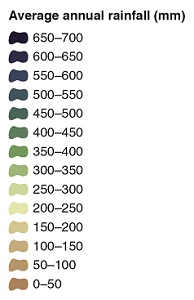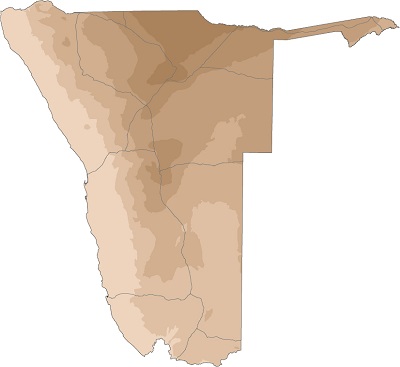Climate change
Two aspects of climate change are definite. First, the earth has been getting hotter and sea levels have been rising. Those trends are certain to continue. Second, the exact effects of climate change on other aspects of the weather and environment are hard to project. This is not to deny the many possible and damaging effects of climate change, and thus the urgent need to reduce human-induced global warming.
Representative Concentration Pathway (RCP) scenarios are used to project changes to the climate. These models assess the influence of different greenhouse gas levels on radiant energy received by, and radiated from, the earth. The maps below depict Scenario 8.5 of the RCP. This scenario assumes that the current rate at which greenhouse gas emissions increase each year will continue throughout the twenty-first century.
3.23 Projected changes in rainfall by 206034
Rainfall, 1960–1990

Projected rainfall, 2040–2060


Projected change in annual average rainfall




Total annual rainfall across Namibia, for the period 2040–2060, is expected to decrease by nearly 9 per cent relative to historical (1960–1990) rainfall. All months of the year are expected to be drier, with rainfall in the rainy season (October to April) expected to drop by 8 per cent and in the dry season (May to September) by 20 per cent.
Much of the African continent, however, is expected to receive higher rainfall than it currently does. Substantial changes in rainfall over the East African Rift Valley could have serious implications. For example, Lake Victoria that feeds (and is the source of) the Nile River, receives more than 85 per cent of its water directly from precipitation; with an increase in rainfall, floods would become a serious risk.
3.24 Projected changes in temperature by 206035
Temperature, 1960–1990

Projected temperature


Projected change in annual average temperature




Temperatures are expected to increase progressively as one moves eastwards from the coast. Mean annual temperature across Namibia is projected to increase by 3 degrees Celsius, with all months of the year becoming substantially warmer. Increases in temperature across central Africa are projected to be more moderate, while the greatest increases in temperatures across Africa are expected to occur in the Saharan region where they might increase by as much as 3.8 degrees Celsius.
3.25 Greenhouse gas emissions and renewable energy opportunities36



The main greenhouse gases contributing to climate change are carbon dioxide, methane, nitrous oxide and fluorinated gases. Carbon dioxide and methane gases generated from human activities come largely from combustion, especially of fossil fuels, solid waste and vegetation. Methane, considered a more potent greenhouse gas than carbon dioxide, is produced by the livestock industry and is a very significant contributor to emissions in countries such as the United States of America and China.
In the global context, Namibia's contribution to greenhouse gas emissions is insignificant. Its carbon dioxide emissions are hundreds of times lower than those of countries with the highest emissions, and its methane production is thousands of times lower. Namibia's relative contribution to global climate change is thus minimal (note the logarithmic scale of the y-axis in the graphs above).
High levels of solar radiation and powerful coastal winds provide Namibia with the opportunity to become a frontrunner in green energy production. For example, a 100-hectare solar park built near Mariental in 2019 generates 45 megawatts of electricity which feeds into the NamPower grid and is sufficient to supply electricity to 70,000 homes. In the urban setting, many shopping malls and other buildings in Windhoek and elsewhere now have their rooftops decked with solar panels. Independent power producers across the country already make a significant contribution to the generation of energy and this is expected to increase as more solar power plants are constructed. Similarly, the energy from Namibia's strong winds, particularly those in the southern Namib Desert, is being harnessed through the wind turbines of newly constructed wind farms, such as the Ombepo Wind Farm positioned south of Lüderitz, further enhancing the national energy mix (figure 10.20). It is expected that in coming years there will be four wind farms with a total of 98 wind turbines located in the extreme southwestern reaches of the country. By 2030 NamPower expects that 70 per cent of Namibia's electricity requirements will be generated from renewable sources. Renewable energy generation, however, also comes at some cost, and there has been conflict between the energy and environmental sectors as many of the prime locations for wind farms are in highly sensitive habitats.

Photo: Google Earth

Photo: J Pallett
The roof of Maerua Mall, one of Windhoek's largest shopping centres, is installed with panels of photovoltaic cells that convert energy from the sun to electricity; they are able to produce at least 1,800 megawatt-hours of electricity per year. Wind along Namibia's southern coast has great potential for generating electricity and is expected to make a significant contribution to Namibia's energy mix by 2030.

